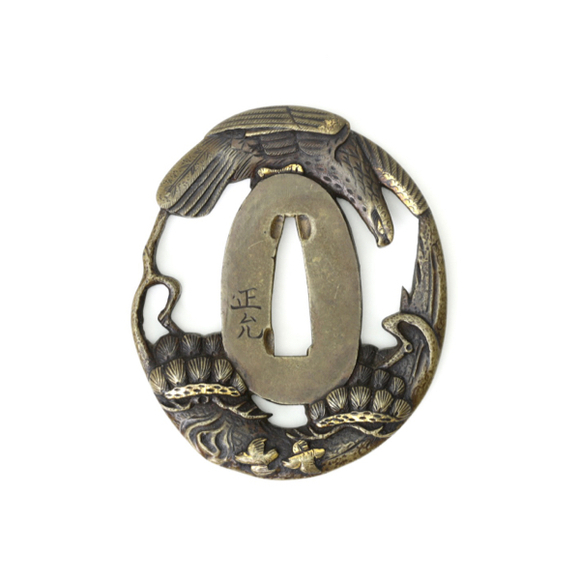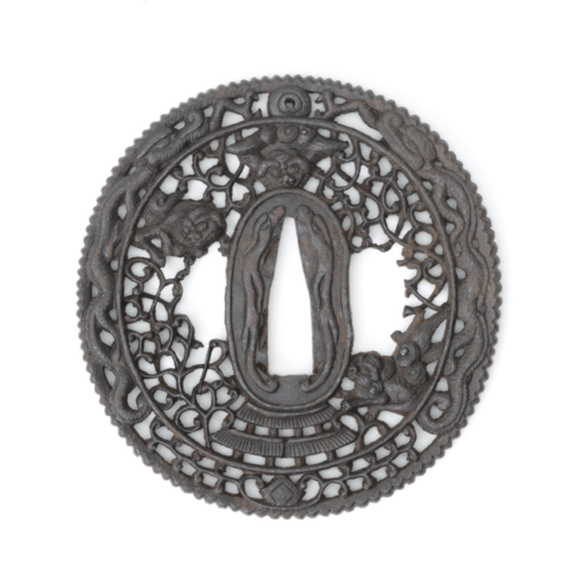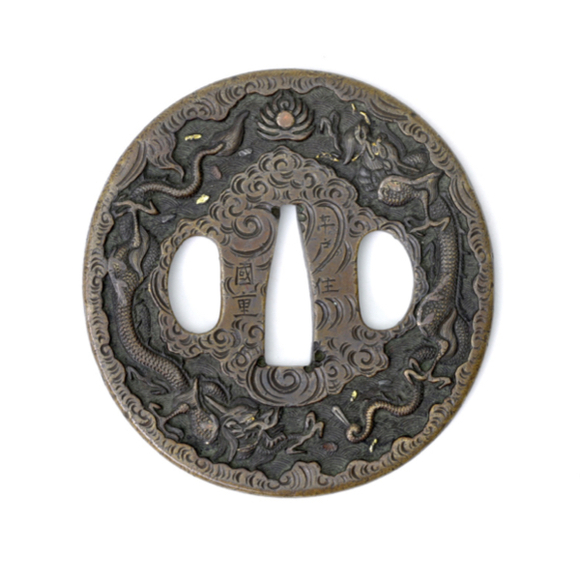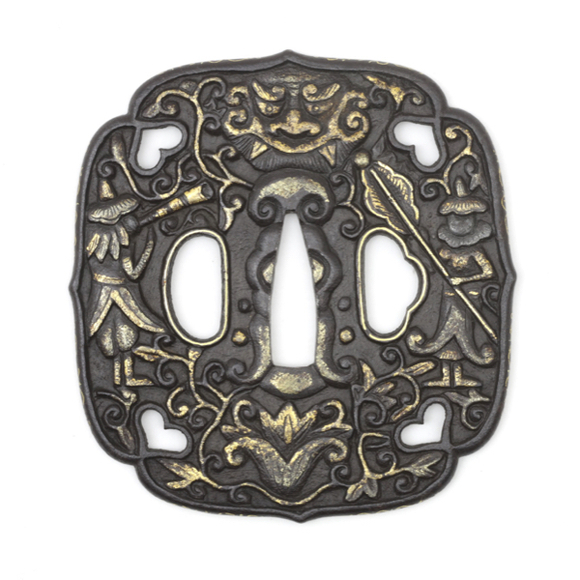Russet iron, one-piece construction with decorative grooves.

In koshirae 100.5 cm
Blade 89.6 cm
Nagasa 69.3 cm
(Length shoulder to tip)
1.6 cm
Kasane (base) 7 mm
Kissaki (tip) 4.5 mm
Kasane (base) 29 mm
Kissaki (tip) 15 mm
Blade 599 grams
With hilt 877 grams
13.2 cm from guard
Blade: Steel
Koshirae: Wood, urushi lacquer, stingray skin (himantura uarnacoides, non-CITES), silk, copper alloy, shakudō, gold
Japan
Blade circa 1700
Koshirae 18th century
From a Japanese gentleman living in the U.S.A.
Introduction
Musashi Taro Yasukuni (武蔵太郎安国) was a Japanese swordsmith who lived between 1650-1730. He was originally a Shitahara school smith from Musashi province but went to Edo somewhere between 1681-1685 to become a student of the eccentric Ōmura Kaboku.
Kaboku was a jiu-jitsu master and physician who was learned in Japanese, Chinese and Western medicine. He had been forging swords as a hobby since 1644 and became a renowned maker, but he kept stressing, even on inscriptions on his sword tangs, that it was just a hobby. Kaboku was, however quite full of himself and wrote a book where he stated that only four swordsmiths understood the true secrets of making a masterpiece; Ko-Hoki Yasutsuna, Kamakura Ichimonji Sukezane, O-Sa, and... himself!
In 1685 both were hired by Mito-daimyō Tokugawa Mitsukuni, grandson of Tokugawa Ieyasu, founder of the Tokugawa Shogunate. Kaboku was hired as a physician and intellectual companion, Yasukuni as a swordsmith producing at least one sword for Mitsukuni himself. According to the Nihon to Zuikan, Yasukuni at some point lost an arm after which Kaboku is said to have helped him make swords. In 1699, Kaboku resigned from service. He initially survived an attempt at assassination by smothering his assailant with his own, severed hand, but took his own life after the fact. A strange end for one of the most eccentric figures of the Japanese sword world.
In 1721, the 8th Shogun Tokugawa Yoshimune, ordered Yasukuni to participate in the sword-forging exhibition in the lord’s residence in Edo. He later went to work in the Edo shogunate residence Hama-goten and later still for the bakufu-retainer Togawa Michitomi.
Yasukuni was the teacher of Musashimaru Yoshiteru (武蔵丸吉英), who became one of the teachers of Suishinshi Masahide (水心子正秀) who developed himself as a grandmaster swordsmith, considered the founder of Shinshintō sword making, hailing in a revival of "golden age" Heian and Kamakura period styles of sword making.
This revival however probably started with Kaboku, who studied Kotō swords extensively and said he was very familiar with Ko-Hoki Yasutsuna's famous Dojigiri or "demon cutter". Now a national treasure. In his book Kento Hiho (劍刀秘宝) "Secret Treasures of The Sword," he explained a 15 layer kōbuse technique that he used on many of his swords. These techniques were passed down to Yasukuni, all the way down to Suishinshi Masahide.
Yasukuni passed away in 1730 at age 81. Four generations followed but none of them matched the workmanship of the 1st generation.
For more information, see my glossary article: Musashi Taro Yasukuni (武蔵太郎安国).
This sword
A katana by first generation Musashi Taro Yasukuni. The first thing you will probably notice when handling it is the tiny, tiny point (kissaki). The blade is in the beautiful shape of earlier Kamakura swords, with a curvature centered in the lower portion of the blade, combined with a wide base and a small tip. The work is well executed, with a tight hada and consistent hamon.

Attributes
(Plain English below)
Sugata: Ubu, zaimei. One mekugu ana. It has a Kamakura era sugata, with much funbari and a ko-kissaki.
(Shape: Unshortened, signed by the maker. One peg hole. Kamakura era shape with much tapering in width from base to tip and a small point.)
Jigane: A rather tight itame with some masame near edge. Small ji-nie. Ichimai-bōshi.
(Steel: A rather tight wood grain pattern with straighter grain near edge. Small martensite particles above the temperline. Fully tempered tip.)
Hamon: Gunome-midare-choji in nioi-deki with some ko-nie. Some sunagashi.
(Temperline: Undulating with clove shapes in small martensite crystals appearing as a mist, with some slightly larger, individually visible particles. Some arrangements of martensite crystals form patterns like brushed sand in a garden.
The signature on the nakago reads:
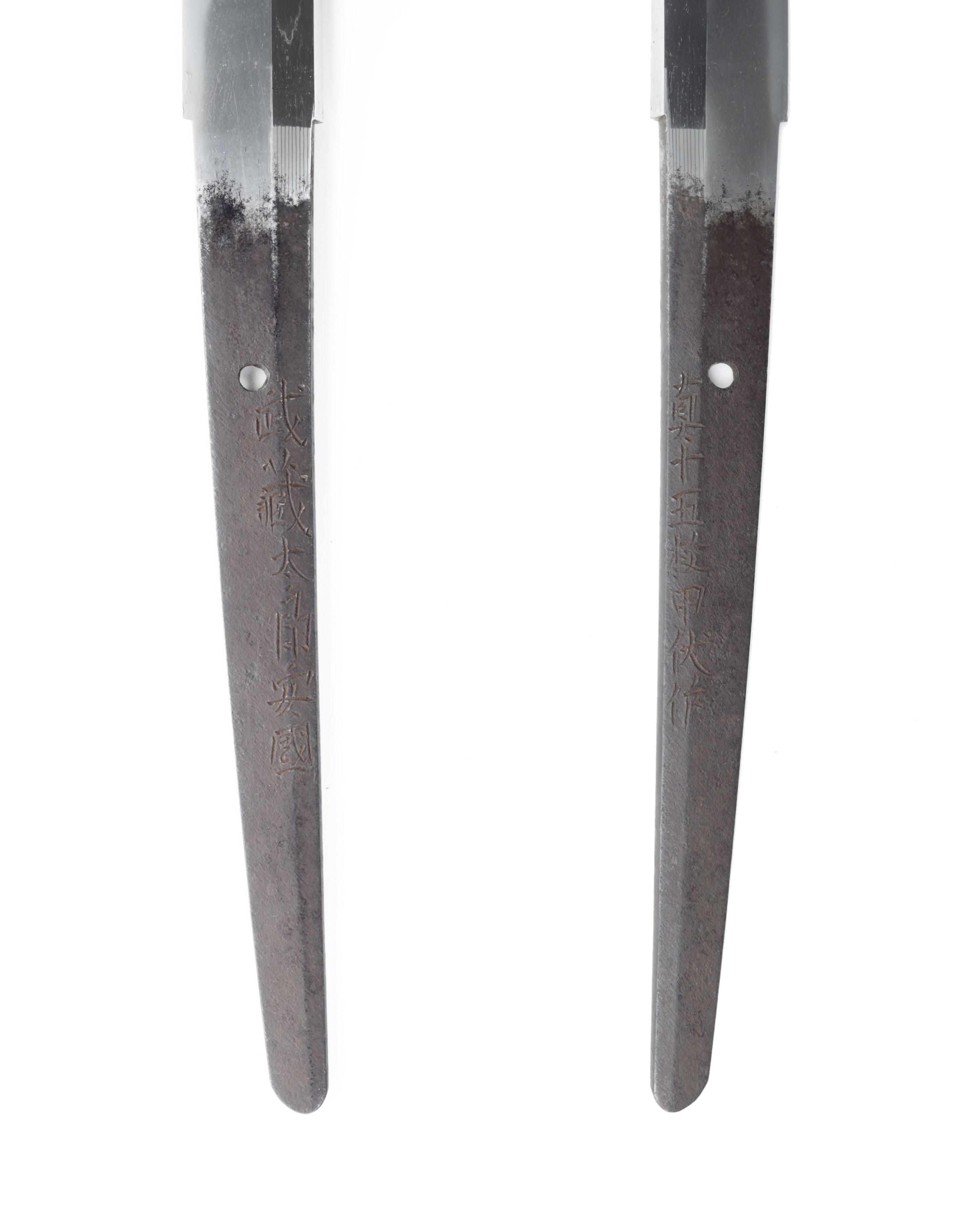
Musashi Taro Yasukuni
shin jūgomai kōbuse saku
"Made by Musashi Taro Yasukuni
in real 15-layer kobuse"
Shin jūgomai kōbuse
Kaboku's book explains that using this technique, the core steel of the sword is forge-folded 15 times. There is another separate edge core piece, and then the whole is wrapped with a high-carbon steel jacket.



N.B.T.H.K. Hozon papers of the 17th year of Hesei; 2005.
It confirms the authenticity of the signature.
Condition
The blade is tightly forged. Some small pits and a tiny nick in the edge remain; see photos.
Unusual koshirae
The sword comes in a full set of Edo-period koshirae. The scabbard is lacquered and divided in two sections. The upper half is lacquered in orange and gold with diagonal lines resembling falling rain. The bottom half is dark brown.

It comes with an old silk strap with dragons woven into the fabric.

The tsuka (hilt) is covered with white ray-skin with fine black silk wrap. Under the wrap are two gilt menuki in the shape of Chinese shishi lion.


Asian export art inspired mounts
It has copper mounts that are inlaid with gold patterns and cartouches with shakudō panels with golden flower designs over a nanako background. The work is unusual in that it resembles colonial wares made primarily for the Dutch presence in Asia. The kashira (pommel) is shaped like an Indian betel box called pandan, a form that also inspired Dutch tobacco boxes made all across the colonies.

Comparison between these hilt mounts and:
Upper left: An Indian betel box, 18th century. Author's collection.
Upper right: Asian export tobacco box for the Dutch market.
Rijksmuseum, Amsterdam accession number NG-1994-11.
The shakudō guard is mokkō-gata, meaning "four-lobed". It shows a garden scene with peony flowers and a seated Chinese figure over a stippled background. It has a separate silver rim that is beaded in the Chinese-style.

A kogai (hairpin) in the Gotō style, also exhibiting a lion, like the menuki, completes this tasteful and unusual set of koshirae.





























Unusual tsuba with foreign figures and Chinese auspicious symbols.



